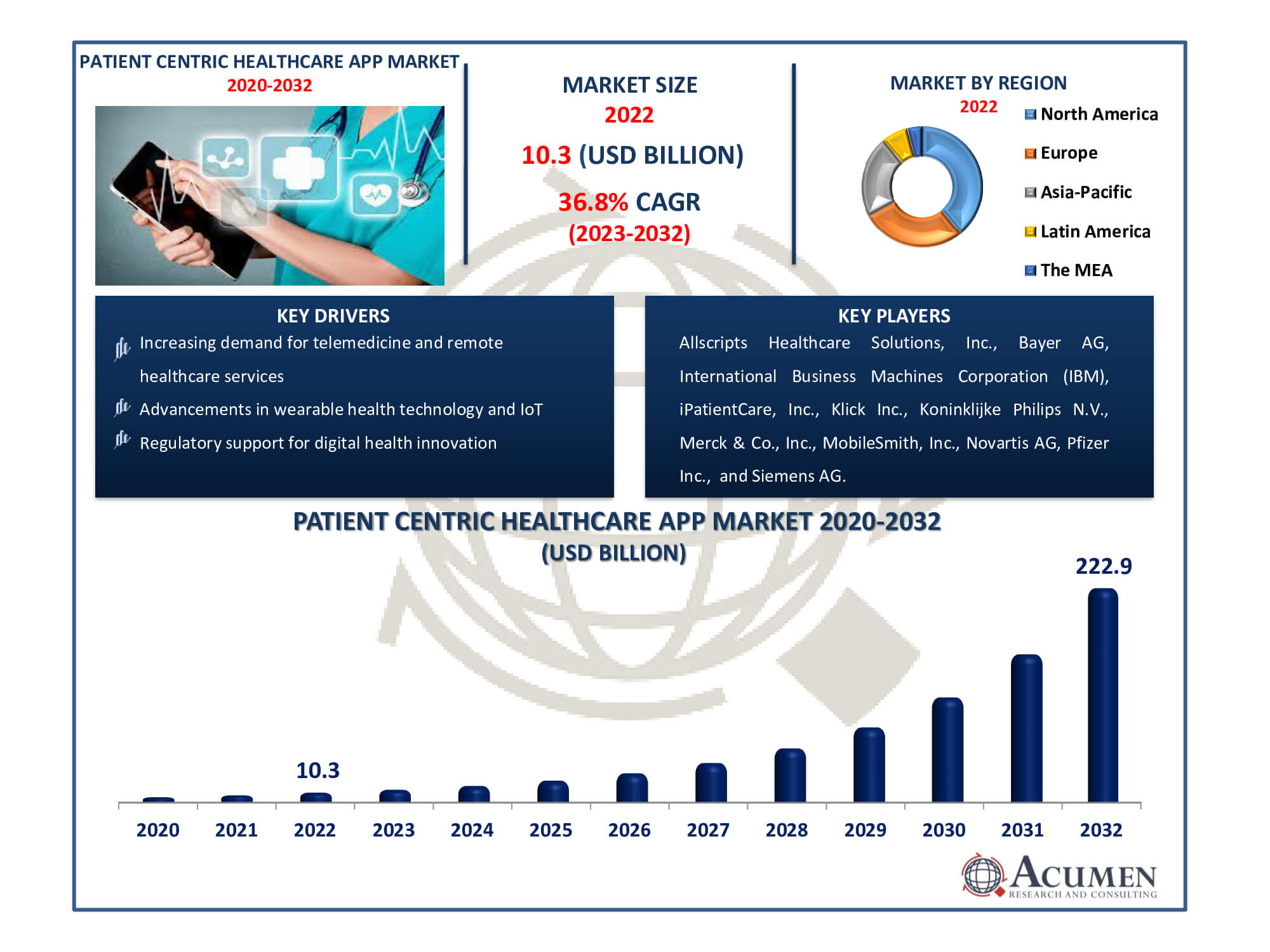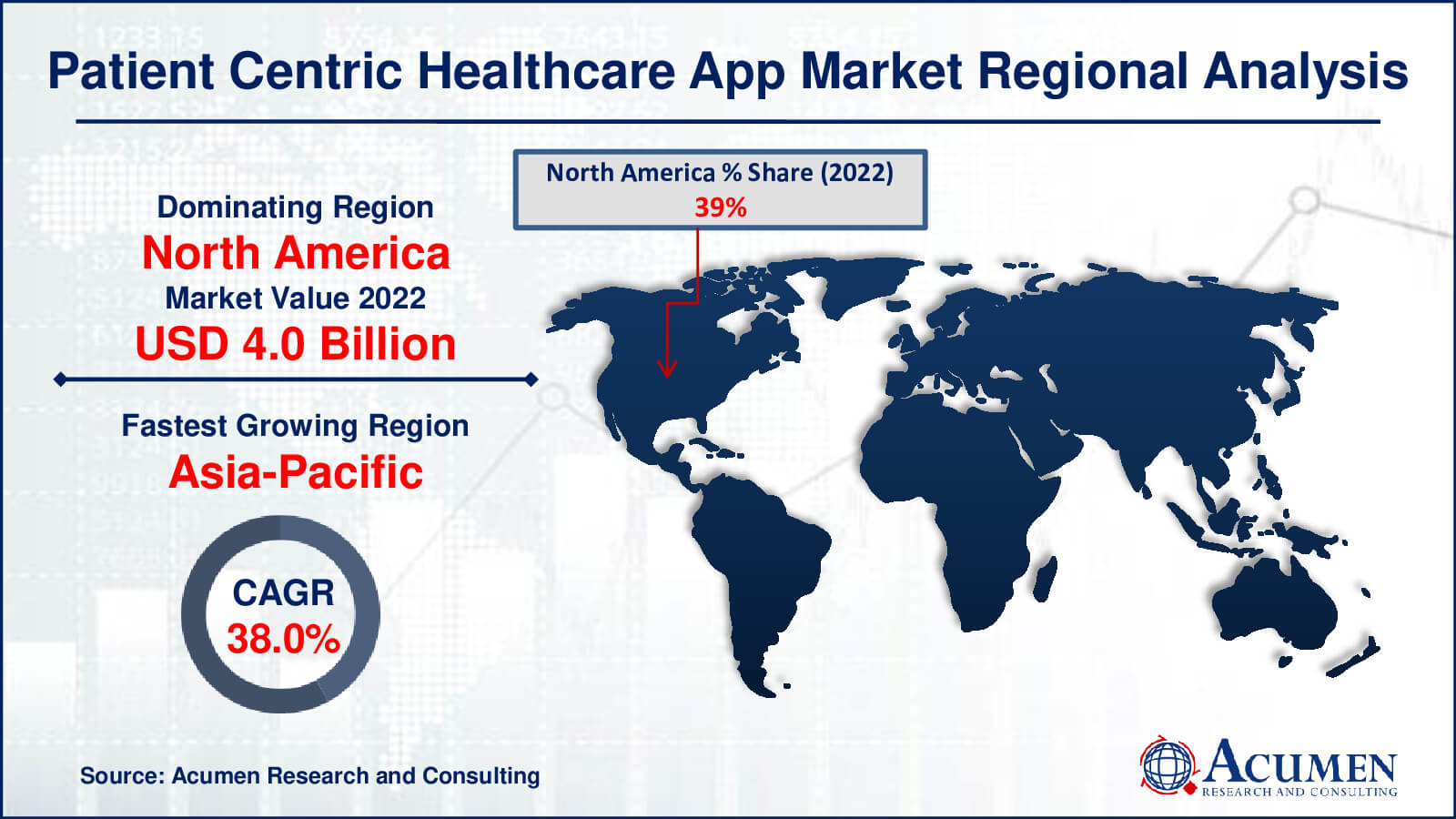Patient Centric Healthcare App Market Size accounted for USD 10.3 Billion in 2022 and is estimated to achieve a market size of USD 222.9 Billion by 2032 growing at a CAGR of 36.8% from 2023 to 2032.
The Patient Centric Healthcare App Market Size accounted for USD 10.3 Billion in 2022 and is estimated to achieve a market size of USD 222.9 Billion by 2032 growing at a CAGR of 36.8% from 2023 to 2032.
Patient Centric Healthcare App Market Highlights

The patient-centric healthcare app market has witnessed significant growth as a result of the proliferation of software applications designed to run on electronic devices such as mobile phones, laptops, and tablets. These applications are dedicated to managing various health-related aspects, including weight management, calorie tracking, and chronic disease management. Patients rely on these apps for monitoring and maintaining chronic health conditions like diabetes and hypertension, while fitness enthusiasts use them for wellness management. Patient-centric healthcare apps have emerged as crucial resources in today's quickly changing healthcare environment, enabling people to take control of their health. These apps provide access to a multitude of health resources and information, as well as personalized health monitoring and telemedicine capabilities. The integration of wearables, artificial intelligence, and real-time data tracking, among other technological advancements, has made patient-centric healthcare apps highly promising for the future of healthcare. These apps present unheard-of opportunities for enhanced patient outcomes and comprehensive wellness management.
Global Patient Centric Healthcare App Market Dynamics
Market Drivers
Market Restraints
Market Opportunities
Patient Centric Healthcare App Market Report Coverage
| Market | Patient Centric Healthcare App Market |
| Patient Centric Healthcare App Market Size 2022 | USD 10.3 Billion |
| Patient Centric Healthcare App Market Forecast 2032 | USD 222.9 Billion |
| Patient Centric Healthcare App Market CAGR During 2023 - 2032 | 36.8% |
| Patient Centric Healthcare App Market Analysis Period | 2020 - 2032 |
| Base Year |
2022 |
| Forecast Data | 2023 - 2032 |
| Segments Covered | By Category, By Technology, By Operating System, By End-User, And By Geography |
| Regional Scope | North America, Europe, Asia Pacific, Latin America, and Middle East & Africa |
| Key Companies Profiled | Allscripts Healthcare Solutions, Inc., Bayer AG, International Business Machines Corporation (IBM), iPatientCare, Inc., Klick Inc., Koninklijke Philips N.V., Merck & Co., Inc., MobileSmith, Inc., Novartis AG, Pfizer Inc., and Siemens AG. |
| Report Coverage |
Market Trends, Drivers, Restraints, Competitive Analysis, Player Profiling, Covid-19 Analysis, Regulation Analysis |
Patient Centric Healthcare App Market Insights
The patient-centric healthcare app market is experiencing significant growth, driven by several key factors. Increasing smartphone penetration, a growing demand for personalized care apps, and global digitalization efforts have all contributed to this expansion. Patients' rising awareness of innovative patient-centric apps and their inclination to use such apps for managing chronic conditions like diabetes and hypertension have added to the market's value.
Moreover, there is a heightened focus on wellness management across various segments, including fitness, lifestyle, stress, and diet and nutrition. The COVID-19 pandemic and the resulting closure of gyms and fitness facilities during nationwide lockdowns have further boosted the use of patient-centric healthcare apps for fitness management. However, some limitations exist, such as the lack of adequate training for healthcare professionals and an insufficient supply-to-demand ratio. These factors may constrain market growth during the forecast period from 2023 to 2032. Additionally, ongoing investments in the development of technologically advanced healthcare apps are expected to create potential opportunities in the coming years.
The combination of artificial intelligence (AI) and machine learning presents a substantial opportunity in the market for patient-centric healthcare apps. These technologies have the potential to improve personalized healthcare insights, treatment recommendations, and diagnostic accuracy. Healthcare apps that incorporate AI may give users insightful real-time data analysis, which can enhance patient outcomes and make the healthcare ecosystem more effective. This will eventually improve user pleasure and experience.
Patient Centric Healthcare App Market Segmentation
The worldwide market for patient centric healthcare app is split based on category, technology, operating system, end-user, and geography.
Patient Centric Healthcare App Category
Presently leading the patient centric healthcare app market is the disease and treatment management category. Management and monitoring of chronic diseases are critically important, which is why they are dominant. Patients with chronic diseases can benefit greatly from the capabilities that these healthcare applications offer, such as symptom tracking, medication reminders, and real-time access to treatment plans. Diseases like diabetes and hypertension are becoming more common, which increases market demand. As other categories, such as wellness management, are important, the illness and treatment management sector is the preferred option for both patients and healthcare professionals since it meets a pressing healthcare need.
Patient Centric Healthcare App Technology
According to the patient centric healthcare app market forecast, the phone-based apps segment will continue to hold a dominant position in the patient-centric healthcare app market. The popularity of smartphones, which provide handy and accessible venues for healthcare apps, is to blame for their domination. User-friendly, phone-based apps are widely adopted across a wide range of demographics, according to market analysis. Furthermore, smartphones are flexible for health monitoring due to the quick advances in technology. Wearable apps are becoming more popular, but the phone-based market still holds a leading position because of its greater reach and flexibility, which meets the market's increasing need for easily available patient-centric healthcare solutions.
Patient Centric Healthcare App Operating System
The patient centric healthcare app market is presently dominated by the android operating system segment, and the market forecast anticipates this trend to persist. The main cause of this domination is that Android devices are widely available and reasonably priced, making a wider range of people able to purchase them. Because android is open-source, a vibrant healthcare app development community is supported, providing a wide variety of patient apps. Based on market analysis, the Android category appears to be well-positioned for growth due to its ability to serve a wider user base, which is in line with the growing desire for user-friendly and affordable healthcare solutions that focus on the patient.
Patient Centric Healthcare App End-User
As per the patient centric healthcare app industry analysis, the home use category frequently leads the industry. Numerous factors contribute to this supremacy. First off, people are becoming more and more interested in healthcare applications that they can use at home to manage their health as a result of the growing trend of patient empowerment and self-care. Furthermore, a wide range of users find these apps to be quite appealing due to their accessibility, privacy, and ease. People's need for remote healthcare solutions during the COVID-19 pandemic further accelerated the development of healthcare apps for home use. Because it is user-centric and easily accessible, this section of the market is continuing to gain traction.
Patient Centric Healthcare App Market Regional Outlook
North America
Europe
Asia-Pacific
Latin America
The Middle East & Africa

Patient Centric Healthcare App Market Regional Analysis
In 2022, North America dominated the global patient-centric healthcare app market, accounting for the highest revenue share. This can be attributed to significant contributions from major economies within the region, particularly the United States and Canada. The increasing aging population in North America, coupled with the growing risk of chronic diseases, has further boosted the regional market's value. The number of Americans aged 65 and older is expected to nearly double, from 52 million in 2018 to 95 million by 2060, creating a substantial demand for patient-centric healthcare apps.
On the other hand, Asia-Pacific is poised for the most rapid growth with a substantial compound annual growth rate (CAGR). The emerging economies of the region, notably China and India, are making substantial contributions to the regional market's value. Technological advancements in Asia-Pacific, along with the widespread penetration of smartphones and network connectivity, are driving the regional market's growth.
The need for patient-centric healthcare apps is being driven by the growing use of digital health solutions and the focus on patient involvement in Europe. Proactively pursuing healthcare innovation and having a well-established healthcare infrastructure are advantageous for the European market. With improved access to healthcare services and growing awareness of the advantages of patient-centric apps, Latin America and the Middle East are also showing potential. As these areas adopt digital healthcare solutions, consistent growth is anticipated. Based on elements unique to each region's healthcare sector and rates of technological adoption, the patient-centric healthcare app industry shows promise for expansion overall.
Patient Centric Healthcare App Market Players
Some of the top patient centric healthcare app companies offered in our report includes Allscripts Healthcare Solutions, Inc., Bayer AG, International Business Machines Corporation (IBM), iPatientCare, Inc., Klick Inc., Koninklijke Philips N.V., Merck & Co., Inc., MobileSmith, Inc., Novartis AG, Pfizer Inc., and Siemens AG.
For inquiries regarding discounts, bulk purchases, or customization requests, please contact us at sales@acumenresearchandconsulting.com